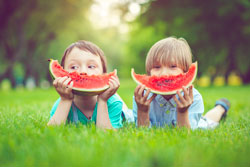Trends and happenings that affect the well-being of our loved ones, from infants to adolescents
Teens decreasing soda consumption
 On a considerably lighter note, America’s high schoolers seem to be abandoning sweetened sodas, according to the U.S. Centers for Disease Control and Prevention. The study, released in February, found that from 2007 to 2015, daily soda consumption among U.S. high school students “decreased significantly,” from 33.8 percent to 20.4 percent.
On a considerably lighter note, America’s high schoolers seem to be abandoning sweetened sodas, according to the U.S. Centers for Disease Control and Prevention. The study, released in February, found that from 2007 to 2015, daily soda consumption among U.S. high school students “decreased significantly,” from 33.8 percent to 20.4 percent.
However, daily milk and juice consumption declined from 2011 to 2015, from 44.3 percent to 37.4 percent and from 27.2 percent to 21.6 percent, respectively. “The decline in milk consumption is a specific concern for adolescents because milk is a key source of calcium and vitamin D in the diets of persons in the United States; both are important for bone development, yet are under consumed,” according to the CDC.
Beverages contribute approximately 20 percent of calories to the diets of children and adolescents, and can contain important nutrients, the report says. The 2015-2020 Dietary Guidelines for Americans recommend choosing beverages that are calorie-free (such as plain water), or that contribute beneficial nutrients – such as fat-free and low-fat milk and 100 percent juice – instead of less nutritious options.
The CDC report attributes the decline in soda consumption to factors such as new federal Smart Snacks in School nutrition standards, which eliminated the sale of non-diet soda in high schools beginning in the 2014-2015 school year, and community-based educational campaigns such as Rethink your Drink.
Despite the decline in daily soda consumption, overall consumption of sugar-sweetened beverages such as soda and fruit drinks remains high, says the report. To decrease consumption of these drinks, the CDC recommends several measures. “Parents can influence the home nutrition environment through their food purchases,” the report says. Additionally, schools can ensure that students have access only to healthier foods and beverages, provide opportunities for students to learn about healthy eating, and use marketing and promotion strategies to encourage healthy choices.
To view the report and the CDC’s recommendations for parents, schools and healthcare providers, visit https://www.cdc.gov/mmwr/volumes/66/wr/mm6604a5.htm?s_cid=mm6604a5_w.
Staying safe in the crib
With approximately 3,500 sudden unexpected infant deaths a year in the United States, several states are following a Finnish child care model to mitigate the problem, according to a March article by National Public Radio.
New Jersey, Ohio, and Alabama are partnering with California-based Baby Box Co. on a program that makes free “baby boxes” available to the families of all newborns in those states. According to NPR, “Parents watch online videos about [SIDS, or Sudden Infant Death Syndrome] and safe sleep and complete a short quiz. They can pick up a box at a local distribution center or have it mailed to them. The sturdy, portable box comes with a firm foam mattress and tight-fitting sheet; also included are breastfeeding accessories, a onesie, diapers and wipes.”
The videos, which last 15-20 minutes, reflect American Academy of Pediatrics safe sleep guidelines, including advice to put babies to sleep alone on a firm mattress, with no toys or soft bedding in the crib, according to NPR. “In most cases, a baby box can be used for the first six months of life,” says the article. “The risk of SIDS is greatest between two and four months.”
Still, some experts are skeptical about the program’s effectiveness. “The people who can really benefit from this are those who don’t have any clue what you need when you take a baby home,” Kristi Watterberg, M.D., chair of the AAP committee on the fetus and newborn, told NPR. She doesn’t want to see the videos take the place of prenatal care, which, the article says, “remains the most important factor for healthy babies.”
For the full NPR article, visit http://www.npr.org/sections/health-shots/2017/03/26/521399385/states-give-new-parents-baby-boxes-to-encourge-safe-sleep-habits.